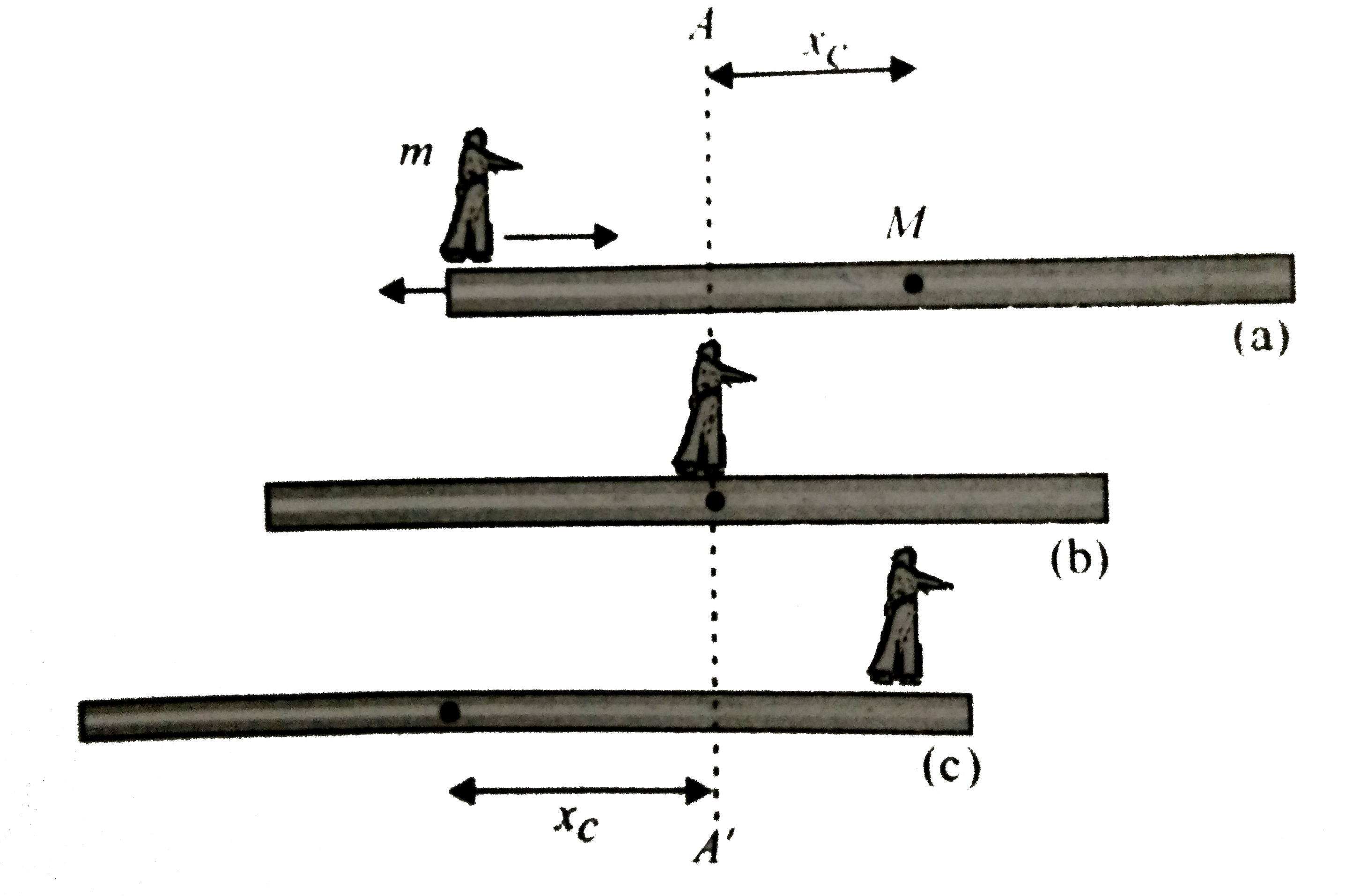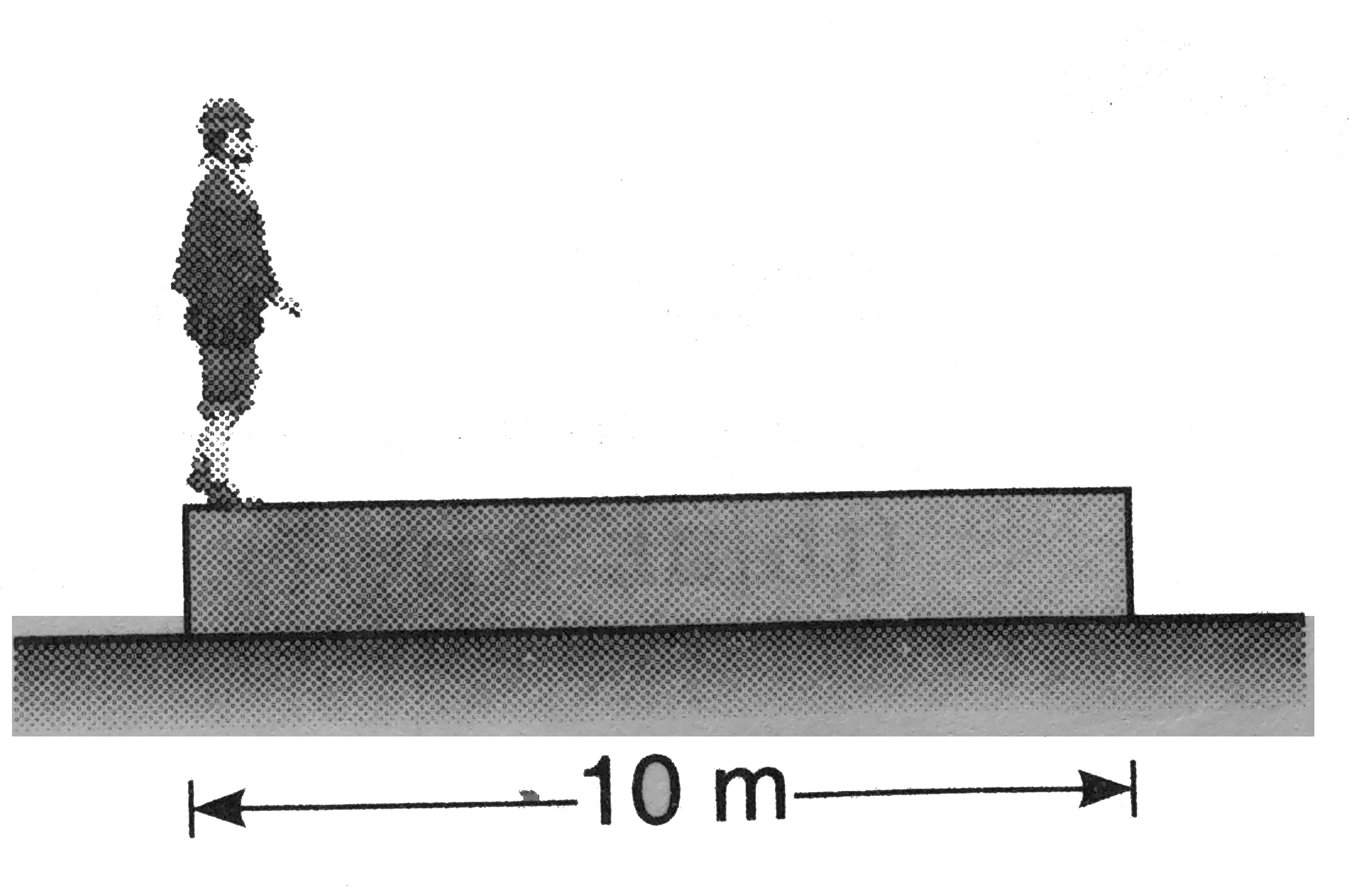A plank of mas M and length L is at rest on as frictionless floor. The top surface of the plank has friction. At one end of it a man of mass m is standing as shown in figure. If the man walks towards the other end the find the distance, which the plank moves a till the man reaches the centre of the plank. b. till the man reaches the other end of the plank.

Method 1: The corresponding situation can be better explained with the help of figure. Consider the man and the plank as a system of which no external force ia acting. The centre of mass of the system must remain stationary. The only interaction force between the man and the plank is the friction as shown in figure, due to which of the man walks along the plank and the friction on plank would be in opposite direction, due to which pland moves towards left, such that the centre of mass of the plank plus man remains at rest. just before the motion started, the initial distance of the centre of mass from the centre of the plank is xc=m×L2+M×0m+M=m×L2m+M

initially the centre of mass of the system is on line AA' as shown in figure. During motion of the man, this centre of mass must remain at this line only . As the man moves towares ramains on AA'. Thus, when the man reaches the centre of the plank, the plank's centre must also reach the same point so that the centre of mass is the same position. Up to this instant the plank moves by a distance xc. Similarly, when the man reaches the other end, plank has to move towards left further by xc to maintain the position of centre of mass.
As there is no external force on the system (man+plank) and the system is initially at rest, there should not be movement of centre of mass of the system during the motion of the man.

The displacement of centre of mass is △xCM and is given by
△xCM=m△→xm+M△→xpm+M............i
⇒△→xm=△→xm,p+△→xp=(x−X) where △→xp=−X
(towards left)
As△→xCM=0, from eqn i
0=m(x−X)−MXm+M⇒X=mxm+M
a When x=L2 displacement of block X=mL2m+M
b. when x=L, displacement of block X=mLm+M
Topper's Solved these Questions
- CENTRE OF MASSBOOK - CENGAGE PHYSICS ENGLISHCHAPTER - CENTRE OF MASSEXERCISE - Solved Examples
13 Videos
- CENTRE OF MASSBOOK - CENGAGE PHYSICS ENGLISHCHAPTER - CENTRE OF MASSEXERCISE - Exercise 1.1
20 Videos
- CALORIMETRYBOOK - CENGAGE PHYSICS ENGLISHCHAPTER - CALORIMETRYEXERCISE - Solved Example
13 Videos
- DIMENSIONS & MEASUREMENTBOOK - CENGAGE PHYSICS ENGLISHCHAPTER - DIMENSIONS & MEASUREMENTEXERCISE - Integer
2 Videos
Similar Questions
A plank of mass 2m and length L is al rest on a frictionless horizontal floor At one end of it, a child of mass m is standing as shown in figure If child walks and reaches the other and then the distance travelled by child wrt ground will be
View SolutionA wooden plank of mass 20kg is resting on a smooth horizontal floor. A man of mass 60kg starts moving from one end of the plank to the other end. The length of the plank is 10m. Find the displacement of the plank over the floor when the man reaches the other end of the plank.

View SolutionA man of mass M stands at one end of a plank of length L Which lies at rest on a frictionless surface . The man walks to the other end of the plank. If the mass of the plank is 3M, the distance that the man moves relative to the ground is
View SolutionA plank of mass M and length L is placed at rest on a smooth horizontal surface. A small block of mass m is projected with a velocity v0 from the left end of it as shown in figure. The coefficient of friction between the block and the plank is m, and its value is such that the block becomes stationary with respect to the plank before it reaches the other end.

a. Find the time and common velocity when relative sliding between the block and the plank stops.
b. Find the work done by the friction force on the block during the period it slides on the plank. Is the work positive or negative?
c. Calculate the work done on the plank during the same period. Is the work positive or negative?
d. Also, determine the net work done by friction, Is it positive or negative?
View SolutionA man of mass M stands at one end of a stationary plank of length L, lying on a smooth surface. The man walks to the other end of the plank. If the mass of the plank is M/3, the distance that the man moves relative to the ground is
View SolutionA man of mass M stands at one end of a stationary plank of length L, lying on a smooth surface. The man walks to the other end of the plank. If the mass of the plank is M/3, the distance that the man moves relative to the ground is
View SolutionA man of mass m stands at the left end of a uniform plank of length L and mass M, which lies on a frictionaless surface of ice. If the man walks to the other end of the plank, then by what distance does the plank slide on the ice?
View SolutionA man of mass m stands at the left end of a uniform plank of length L and mass M, which lies on a frictionaless surface of ice. If the man walks to the other end of the plank, then by what distance does the plank slide on the ice?
View SolutionA man of mass m stands at the left end of a uniform plank of length L and mass M, which lies on a frictionaless surface of ice. If the man walks to the other end of the plank, then by what distance does the plank slide on the ice?
View SolutionA log of wood of length l and mass M is floating on the surface of a river perpendicular to the banks. One end of the log touches the banks. A man of mass m standing at the other end walks towards the bank. Calculate the displacement of the log when he reaches nearer end of the log
View Solution
